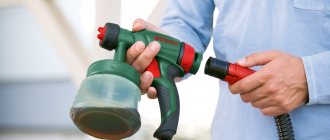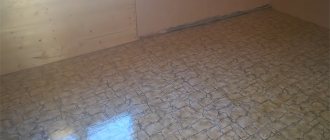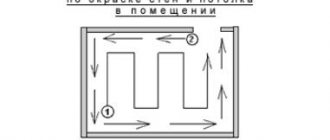Where does typical paint poisoning come from?
If you are thinking about redecorating and are thinking about painting windows, doors, walls and floors, do not forget about basic safety rules when handling paint!
Paints, varnishes and solvents contain toxic substances in abundance: for example, acetone, complex carbons, trichlorethylene.
When they evaporate, they can enter the human body through the upper respiratory tract, and contact with the vapors of these chemicals often results in poisoning of the body.
Possible consequences
Poisoning the body with toxic paint can lead to serious complications. These include:
- Respiratory dysfunction: insufficient oxygen reaches the lungs, which contributes to severe headaches. Paint vapors can cause compression in the chest, difficulty breathing, and a systematic dry cough.
- Disorder in the functioning of the cardiovascular system, blood pressure is greatly reduced.
- Loss of appetite, bouts of nausea all the time.
- Indifference, a constant state of exhaustion, impaired sleep function, and decreased brain activity appear.
- Unpleasant feelings in the eyeballs, a feeling of dryness, redness. Vision decreases significantly due to the regular penetration of toxic vapors into the mucous membrane of the eyeballs.
How can paint affect our well-being?
During prolonged painting work in a closed apartment, and even without a special protective equipment - a respirator, you can easily “inhale” the paint. Volatile substances, when inhaled, enter the mucous membranes of the nose, bronchi and lungs with the air, are absorbed into the blood and poison the body.
By the way, you can get poisoned by paint fumes during repairs not only from fresh paint. Quite often we scrape off or burn off the old coat of paint with fresh paint. The dust of “old generations” contains oxides of lead and mercury. Getting into the lungs, these toxic particles also provoke intoxication.
Consequences and prevention
Paint intoxication can lead to complications.
What happens:
- Conjunctivitis,
- Diseases of the bronchi and lungs,
- Kidney and liver failure,
- Diseases of the digestive system,
- Disruption of the normal functioning of the nervous system.
We recommend: Poisoning with dichlorvos and its vapors - what to do at home
To prevent poisoning from such toxic substances, it is recommended to adhere to some preventive measures.
Paint poisoning: symptoms
In medical terms, acute symptoms appear a few hours after contact with “colorful” substances, and chronic symptoms occur several days or weeks later.
General symptoms of acute intoxication are as follows:
- From the eyes: dryness, burning sensation, redness;
- From the upper respiratory tract: nasal congestion, sneezing, shortness of breath, dry cough and even suffocation;
- From the digestive system: abdominal pain, nausea, unpleasant taste in the mouth, vomiting;
- From the central nervous system: headache, loss of consciousness.
In addition to the general signs of intoxication, each chemical has its own “own” symptoms of poisoning. For example, when poisoned by acetone vapor, a person’s state resembles alcohol intoxication - euphoria, confusion, the air exhaled by the victim smells of acetone.
People who “on duty” come into daily contact with paints, solvents, varnishes and adhesives can become victims of chronic poisoning if they do not follow safety precautions.
Symptoms and causes of poisoning
Intoxication with oil paint and other paint and varnish products manifests itself in acute and chronic forms.
Acute poisoning is often diagnosed in the summer, when people begin to do repairs on their own. At elevated air temperatures, toxic vapors quickly spread and penetrate the body. Such poisoning is characterized by the presence of certain symptoms.
Signs:
- Weakness, apathy,
- Redness of the mucous membrane of the eyes,
- Increased flow of tears
- Burning in the eyes
- Head pain of increased intensity,
- Head spinning
- Nausea, urge to vomit,
- Severe intestinal upset
- Rapid breathing, shortness of breath,
- The smell of acetone from the mouth,
- Pale skin,
- Impaired consciousness.
In rare cases, poisoning may result from ingestion of paint. Unpleasant symptoms occur within twenty minutes after taking the substance.
What's happening:
- Severe pain in the abdomen,
- My breath smells like acetone
- Burning in the esophagus area,
- Nausea, vomiting,
- intestinal disorder,
- Loss of consciousness,
- Rapid heartbeat
- Falling into a coma.
The chronic form appears gradually, symptoms increase over time.
How it manifests itself:
- Bad feeling,
- Digestive disorder
- Unpleasant sensations in the eyes, burning,
- Sleep problems
- Chronic cough.
The appearance of any of the described signs when working with paint requires stopping work and providing assistance to the victim.
First aid for paint poisoning
First aid to the victim is provided immediately!
- The person must be taken out of the room to be painted into fresh air.
- Remove his outer clothing that is saturated with paint fumes.
- Areas of the body not covered by clothing should be washed with water.
- Rinse the stomach with plenty of water and give Enterosgel sorbent.
- Provide warmth: cover with a blanket, give warm tea.
- If the person is unconscious, place him on his side to prevent choking when vomiting.
- Call an ambulance.
Further treatment for severe and moderate poisoning is carried out in the hospital.
Treatment
Intoxication with paint vapors is treated by a toxicologist in a hospital setting and is reduced to gastric lavage, cleansing of the lungs and drip intravenous administration of glucose. The victim is also prescribed sedatives and medications to maintain cardiovascular activity. In severe cases, the patient is hospitalized in the intensive care unit.
In case of chronic intoxication, it is recommended to undergo a comprehensive examination, after which the attending physician will prescribe the necessary procedures and medications (vitamin complexes, hepatoprotectors, immunomodulators) to neutralize the harm caused by toxic drugs. You should seriously think about changing jobs. If this event is not possible, frequent, adequate rest in the fresh air should be provided.
Prevention of paint poisoning
The most important and important point for preventing poisoning is maintaining personal safety when working with chemicals:
- Thoroughly ventilate the room where repair work is being carried out;
- Use a respirator with a special filter, ensuring respiratory protection from exposure to volatile substances and construction dust;
- Work in closed clothing to protect your skin from toxic substances;
- Remove paint immediately if it gets on your skin;
- Protect your eyes with plastic, tight-fitting goggles and your hands with gloves;
- Do not sleep, eat or store food in a freshly painted room;
- If you have the slightest symptoms of paint poisoning, take Enterosgel!
- Providing timely assistance to a person with paint poisoning will minimize the harm caused to health and prevent serious complications!
Poisoning is a painful condition caused by toxic substances entering the body. Toxic substances enter the body through the digestive system, skin, and respiratory tract. Poisoning from paint fumes is one of the most common. The substances that cause them belong to the first, most dangerous class of chemical compounds.
The list of dyes, varnishes, solvents and pigments used in industry and everyday life is growing every year. These substances are part of paints and are used in construction, medicine and printing. They contain almost the entire periodic table of Mendeleev and are extremely dangerous if they enter the human body in the form of vapor or aerosol. These products contain very toxic substances - mercury, arsenic and others.
These poisons enter the body through the respiratory tract when painting work is carried out in unventilated areas, especially if safety precautions are not followed.
Preventive actions
It is easier to prevent poisoning from paint fumes than to subsequently deal with the damage caused to health. Necessary preventive measures when working with paints and varnishes are:
- work in protective clothing, gloves, mask or respirator;
- immediate removal of drops of paint that come into contact with the skin during work;
- ensuring constant air exchange in the work area. You should not eat or drink at the place of work;
- frequent breaks from work with access to fresh air. If you experience dizziness or a smell of acetone in your mouth, painting activities should be stopped for several days.
To work with paint, you must be guided by certain knowledge and skills. A frivolous attitude towards painting work, carelessness and carelessness in handling paints can lead to irreversible consequences.
Paint poisoning: treatment
If a person has inhaled fumes from acetone, varnishes, paints, solvents, he must be removed or taken to fresh air as soon as possible; if this is not possible, all windows must be opened. Afterwards, it is necessary to remove the “infected” clothes from him and wash the exposed areas of the body with clean water. If there is a loss or change in consciousness, coughing, vomiting, drooling, or convulsions, you should urgently call an ambulance. If the victim is unconscious, you should lay him on his stomach, turn his head to the side and clear the airways of saliva and mucus. If breathing is depressed, you will need to perform artificial respiration and cardiac massage.
When saving the victim, do not forget about yourself. Before providing assistance, protect yourself - put on a mask, gloves if necessary, open the windows. If you yourself suffer, it will not be better for anyone.
To prevent poisoning from paint fumes during painting, you must use gloves, a mask, goggles, sealed clothing, do not drink or eat food in this room, after painting you must thoroughly wash your hands and wash your clothes, preferably take Enterosgel for preventive purposes.
It is necessary to try to ensure access to fresh air in the room where work is being carried out. If varnish or paint gets on your skin, remove it immediately using suitable solvents or soapy water.
First aid
If poisoning with paints and varnishes occurs and negative signs appear, then therapeutic measures must be taken. To do this you need to do the following:
- Provide the victim with access to fresh air.
- If possible, the best option is to go outside with him.
- Give the inhaled person a drink of alkaline water in large quantities.
- If the victim faints, lay him on his side and bend one lower limb at the knee so that the position is stable.
- Give the cotton wool with ammonia a whiff.
If a person’s blood pressure has decreased significantly, breathing has become difficult or completely absent, and the heartbeat has increased, then the case is quite serious. In such a situation, be sure to seek help from doctors.
If there is no breathing, place the person on his back, create access to the upper respiratory tract, and perform artificial ventilation. If no pulse is detected in the carotid artery, immediately perform an indirect cardiac massage. Only with quick and precise action can you save human life.
Publications in the media
Poisoning with lead and its compounds ranks first among heavy metal poisonings, especially in large cities • Acute lead poisoning is rarely observed. There are strict regulatory limits on lead content in paints and other products • Lead accumulates in the body, causing chronic poisoning • Poisoning with organic lead compounds (tetraethyl lead) is observed quite often (especially in the case of substance abuse).
Predominant age • Children (usually from 1 to 5 years) • Due to the imperfection of the BBB, even a fairly low level of lead in the blood (10 μg%) can cause toxic damage to the nervous system in children • When lead is taken orally, its bioavailability is 40% in children and 10% in adults. Etiopathogenesis • Lead usually enters the body through inhalation of dust, soot and fumes containing lead, as well as through the mouth (mainly in children); has a psychotropic (stimulating), neurotoxic (degenerative changes in motor neurons), hematotoxic (inhibits Hb synthesis) effect • Tetraethyl lead is found in some types of gasoline and most often enters the body through the lungs when inhaling vapors, and can also penetrate the skin. In the body, organic lead compounds are converted into inorganic ones, causing symptoms of chronic intoxication •• Lead affects all parts of the brain, especially the hypothalamic regions and the reticular formation of the brainstem •• Lead blocks enzymes involved in the synthesis of heme. Hypochromic anemia develops with normal serum iron levels. As a result of disruption of heme synthesis, the excretion of porphyrins and α-aminolevulinic acid from the body (pathognomonic sign of lead poisoning) increases. In addition, lead increases hemolysis of red blood cells • Lead accumulates in bones and is mobilized from bone tissue.
Risk factors • Peculiarities of children's behavior (children often suck fingers, chew and eat inedible objects) • Water pipes made of lead or lead-containing alloys (ingested with water), living in buildings in the construction of which materials containing lead were used; living near factories, roads) • Use of various products containing lead (for example, antimony) • Occupational hazards - plumbers, soldering workers, miners, auto repairmen, lead smelters and refiners, welders and steel cutters, construction workers, gas station attendants, people involved in the production of glass, rubber, and electric batteries.
Clinical picture • Acute poisoning - headache, weakness, dizziness, vomiting, bradycardia, arterial hypotension, sweating, salivation, itching, paresthesia, tremor of the extremities. Symptoms often develop 6 hours - 2 days after poisoning •• When inhaling vapors, neurological symptoms are more pronounced: insomnia, headache, ataxia, convulsions, hallucinations, psychomotor agitation •• When taken orally - dyspeptic disorders: thirst, belching, abdominal pain , nausea, vomiting, diarrhea •• In children for 1–5 days - persistent uncontrollable vomiting, ataxia, convulsions, disturbances of consciousness. • Chronic poisoning , mild and moderate degree of intoxication •• Myalgia, arthralgia, paresthesia, limb tremors, increased fatigue, irritability, memory disorders, insomnia are possible •• Abdominal discomfort, vomiting, weight loss, muscle wasting •• Possible development renal failure. • Severe intoxication (acute or chronic) •• Nutritional syndrome - anorexia, metallic taste (with chronic intoxication - sensation of hair) in the mouth, constipation, intestinal colic, muscle tension in the abdominal wall (sometimes), on the gums - lead (blue-black) border •• Neuromuscular syndrome (more often in adults): painless peripheral neuritis and weakness of extensor muscles •• Cerebral syndrome ••• In chronic poisoning - lead encephalopathy (more often in children) with epileptiform seizures, coma; long-term residual effects, including neurological defects (neurocirculatory triad - arterial hypotension, bradycardia, hypothermia), psychopathological disorders (persistent headaches, insomnia, increased excitability, restless sleep with nightmares), mental retardation (in children) ••• In acute poisoning - hallucinations, delusions, psychomotor agitation, manic syndrome, convulsions.
Laboratory tests • If you are asymptomatic and the level of erythrocyte protoporphyrin is more than 35 μg% (0.62 μmol/l), the lead content in the blood should be checked (blood is collected in a container that does not contain lead!) • The severity of poisoning depending on the lead content in blood •• I - less than 10 µg% (less than 0.48 µmol/l) •• II - 10-19 µg% (0.48-0.92 µmol/l) •• III - 20-44 µg% (0 .97–2.12 µmol/l) •• IV – 45–69 µg% (2.17–3.33 µmol/l) •• V – more than 70 µg% (more than 3.38 µmol/l) • High serum iron level • Blood test - decreased Hb and Ht levels (hypochromic anemia); eosinophilia and basophilic granularity of erythrocytes, reticulocytosis (up to 1%) • Increased content of porphyrins and d-aminolevulinic acid in the urine (tens of times) • Changes associated with impaired renal function in the later stages. Special tests • Calcium ethylenediaminetetraacetate (Ca-EDTA) test is positive when the blood lead level is 25-44 µg% (1.21-2.12 µmol/l) • Bone marrow aspirate - high percentage of sideroblasts • X-ray •• Abdominal X-ray cavity helps to identify the presence of lead particles in the intestine •• X-ray of the long bones reveals compaction of the cartilaginous tissue of the metaphyses (dense transverse stripes). Differential diagnosis • The level of erythrocyte protoporphyrin may be elevated in IDA and, less commonly, in hemolytic anemia • Nutritional syndrome should be differentiated from acute abdominal syndrome • Neuromuscular syndrome - with other polyneuropathies • Cerebral syndrome - with absent-mindedness syndrome, mental retardation, autism , dementia, meningitis and diseases that cause epileptiform seizures.
TREATMENT Regime • In case of acute and severe poisoning - hospitalization in a poison control center, in other cases - outpatient treatment • Treatment of severe psychopathological disorders is carried out in a psychiatric hospital. Diet • If symptoms of poisoning occur, avoid excessive fluid intake • Adequate calcium and iron in the diet • Reduce fat content in the diet (to reduce the absorption and accumulation of lead). Management tactics • For acute poisoning (see also Poisoning, general provisions) •• Gastric lavage through a tube (preferably 2% sodium bicarbonate solution) followed by the introduction of enterosorbent (activated carbon) •• Specific (antidote) therapy •• Infusion therapy and forced diuresis •• Symptomatic therapy - magnesium sulfate, for agitation, convulsions - diazepam. • In case of chronic poisoning •• In case of poisoning of III–V degree, it is necessary to notify the local health department (SES). Identification of the source of intoxication (examination of the home and/or workplace), examination of family members (identification of asymptomatic patients) •• In case of poisoning of the III-IV degree, detoxification drugs are prescribed orally; in case of poisoning of the V degree or III-IV degrees with a detailed clinical picture - parenterally •• In case of poisoning of the IV-V degree, the patient should be protected from all possible sources of lead and the cause of the poisoning should be immediately identified. • The lead content in the blood is determined 7–10 days after treatment with complexones, then 1 time per month until values corresponding to stage I poisoning are reached. Specific (antidote) therapy • Complexones for oral administration - succimer 10 mg/kg every 8 hours for 5 days, then 10 mg/kg every 12 hours for 2 weeks. If the stable concentration of lead in the blood is higher than or equal to 15 mcg%, the course of treatment is repeated, but not earlier than after 2 weeks. • Complexones for parenteral administration are used only after normalization of renal excretory function •• For grade V or clinical manifestations of intoxication - dimercaprol 3-5 mg/kg deep IM every 4 hours for 5-7 days in combination with intravenous infusion of thetacine-calcium 150 mg/kg/day for 5 days. If the lead concentration in the blood is above 45 µg% (2.17 µmol/l) and asymptomatic poisoning, thetacine-calcium (50–75 mg/kg/day) is used for another 48–72 hours (without dimercaprol) •• For IV degrees and without serious clinical manifestations (for example, encephalopathy) - thetacine-calcium 100 mg/kg/day for 5 days. Injections can be repeated after 5–7 days. • Penicillamine orally for a long time (3–6 months).
Course and prognosis • Full recovery is possible only with mild intoxication • With a developed clinical picture, but without pronounced signs of encephalopathy - recovery even without the use of complexones. It is possible that mild manifestations of encephalopathy may persist for a long time • With lead encephalopathy: 25% have a fatal outcome, 15–40% have persistent neurological disorders (convulsions, central paralysis, optic nerve atrophy, mental retardation, mental retardation [in children] , epileptiform seizures), complete loss of ability to work is possible • Development of chronic renal failure, gout - with prolonged contact with lead. Pregnancy • Lead poisoning during pregnancy leads to premature births and premature births • Lead has teratogenic properties. Abbreviations. Ca-EDTA - calcium ethylenediaminetetraacetate
ICD-10 • T56.0 Toxic effects of lead and its compounds
Notes • Screening measurement of erythrocyte protoporphyrin levels in children under 6 years of age without clinical manifestations of lead poisoning is advisable. This test is negative when the lead content in the blood is up to 25 µg% (1.20 µmol/l) • Test with calcium ethylenediaminetetraacetate (Ca-EDTA) - increased excretion of lead in the urine when complexones are introduced into the body; is not widely used due to the difficulty and duration of implementation, which slows down the diagnostic process and delays the start of treatment.











